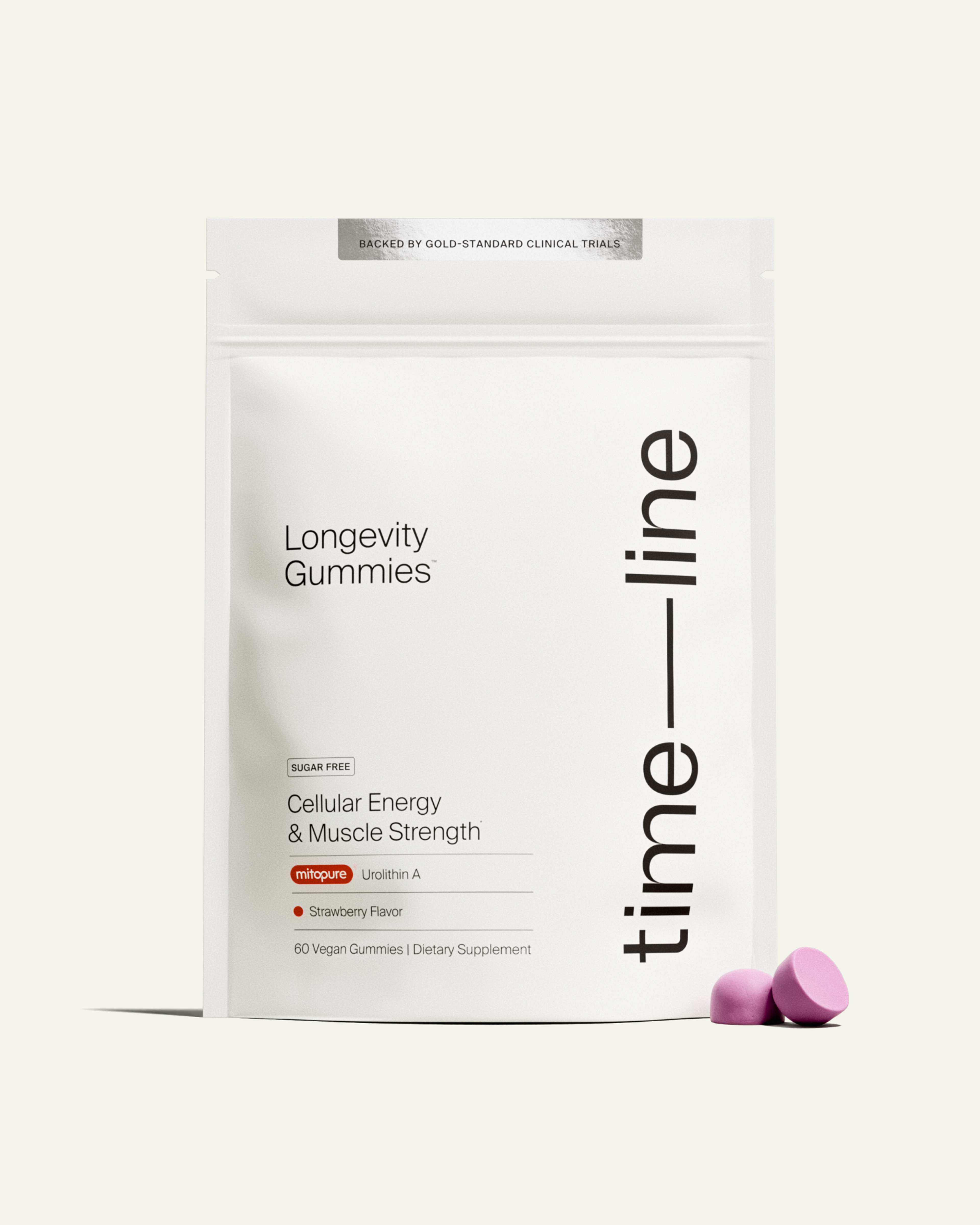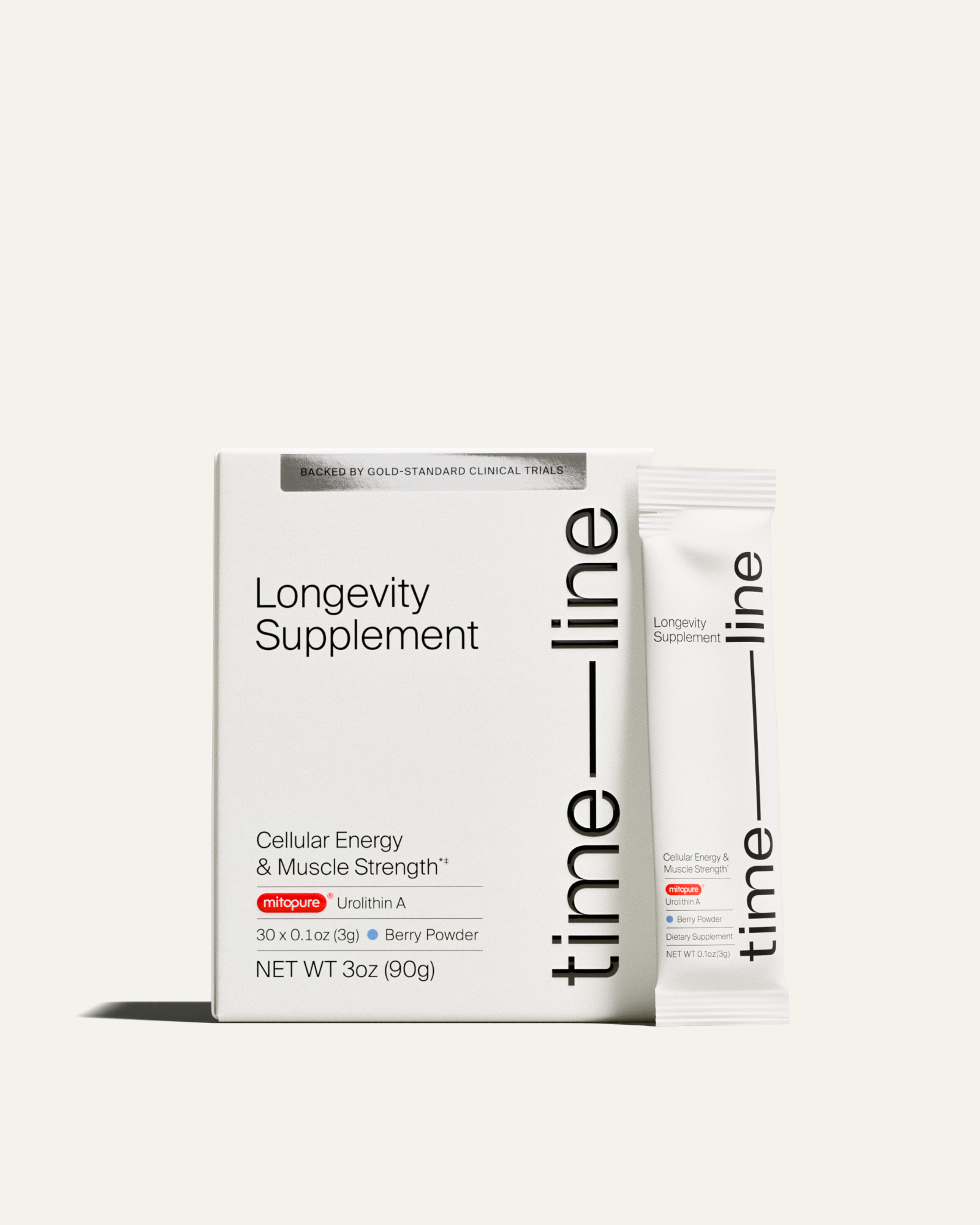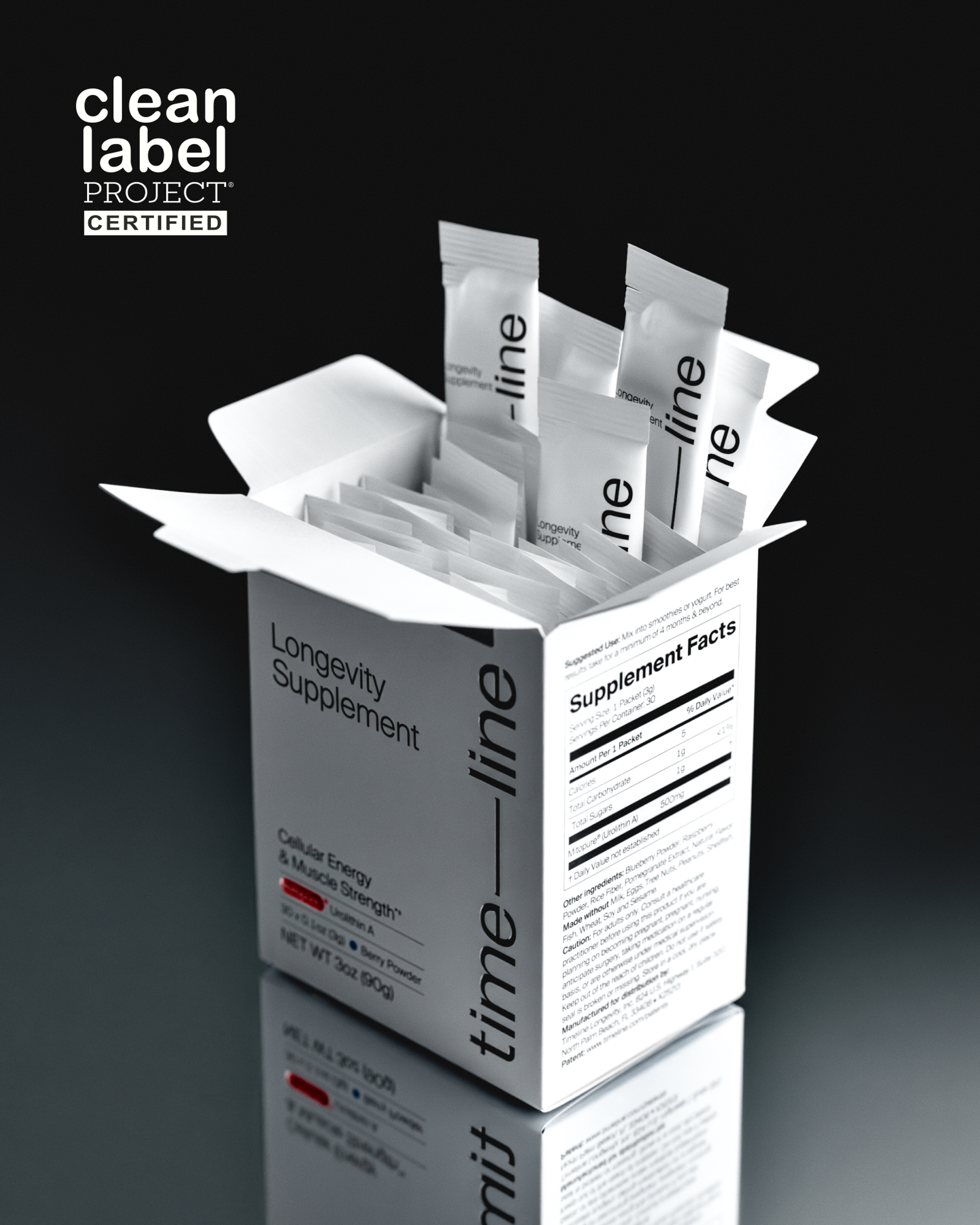Stay Strong After 50: Menopause Muscle Building Guide
Learn how women can build and maintain muscle after 50 through strength training, nutrition, and targeted supplements to stay strong and vibrant.
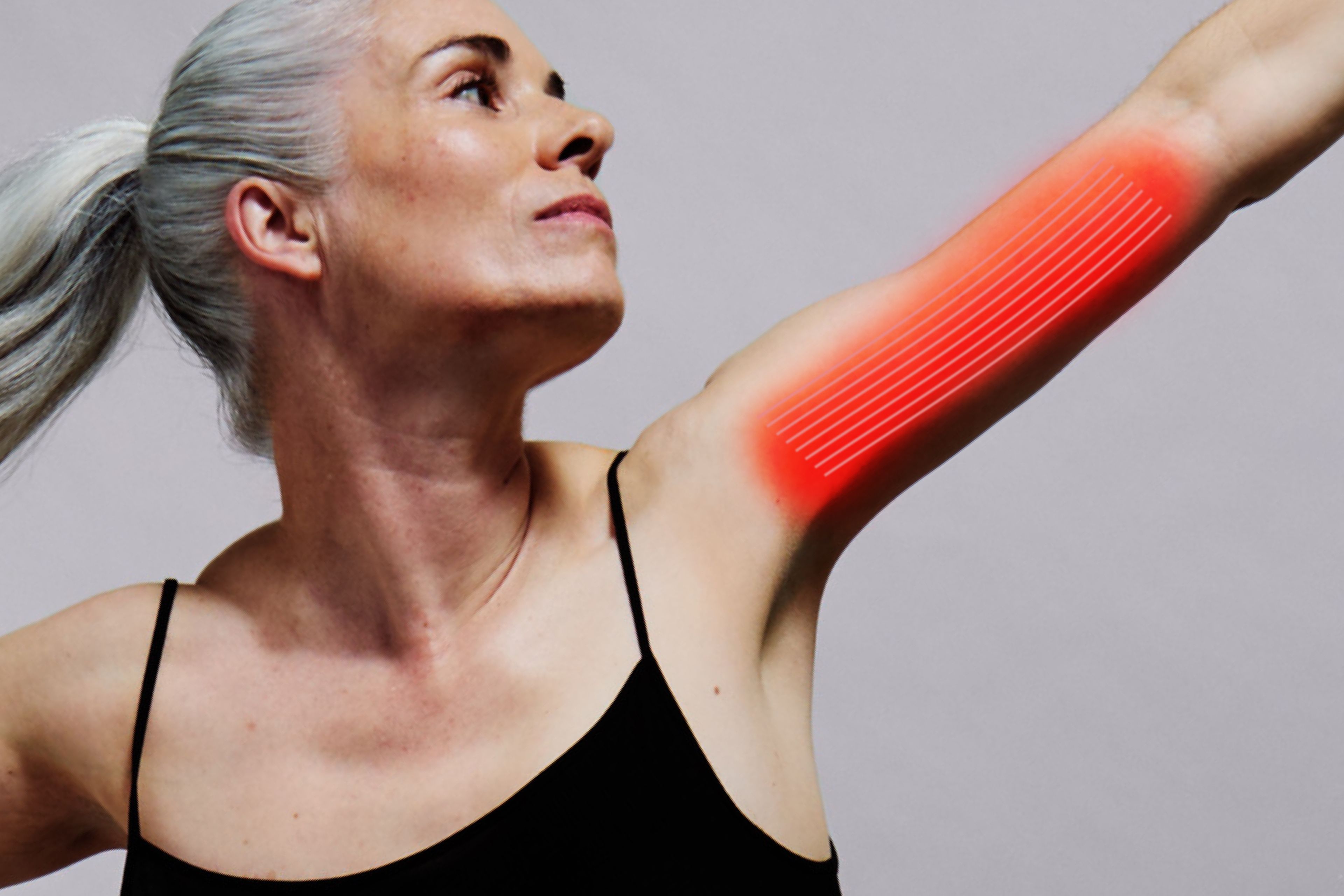
What to know
Menopause leads to a decline in estrogen levels, which significantly impacts muscle mass and strength, contributing to age-related muscle loss.
Estrogen is crucial for muscle growth, repair, and recovery. It also helps reduce inflammation and improve energy metabolism within muscle cells.
Engaging in resistance training exercises at least twice a week is essential for building and maintaining muscle mass and strength during and after menopause.
A balanced diet rich in protein, complex carbohydrates, healthy fats, and essential micronutrients (like calcium, vitamin D, and magnesium) is vital for muscle health.
Supplements like Mitopure® that directly support muscle health, may help women keep muscles strong as they grow older.
As women enter menopause, the changes can feel overwhelming—hot flashes, mood swings, and sleep disturbances, the list goes on. Many of these changes are well known, but one critical aspect that tends to fly under the radar is the impact on muscle health. Menopause muscle loss, which results from the body's declining estrogen levels, doesn’t just affect how you feel physically; it can also impact your long-term health and independence.
But the good news is, with the right strategies, you can protect and even strengthen your muscles during this transformative time. Here's what you need to know about how menopause affects muscle health—and what you can do to stay strong and vibrant.
What is menopause
Menopause marks the point when a woman has gone 12 consecutive months without a menstrual period, signaling the end of her reproductive years. Leading up to this stage is perimenopause, the transitional phase where hormone levels begin to decline. During this time, women may still have periods, though often irregular, and start to experience various symptoms due to the fluctuating and decreasing hormone levels.[1]

What happens to your muscles during menopause
Age-related muscle loss is a serious concern.
Both men and women naturally lose muscle mass and strength as they age, especially if they don't engage in activities to prevent it. For women, the decline in estrogen during menopause adds another layer of complexity, further affecting muscle quality.
Compared to me, women are at an increased risk of sarcopenia—a significant loss of muscle mass that diminishes strength and functional ability.[2] Sarcopenia contributes to frailty, disability, and several adverse health outcomes if left unchecked. This is why it is important for women to focus on building muscles before, during, and after menopause.
Estrogen's role in muscle health
Research on the exact mechanisms of how estrogen impacts muscle health is still underway, but here is what is understood today:
- Muscle mass: Studies suggest that estrogen plays a direct role in muscle mass through through its impact on muscle growth, repair, and recovery. [3]Hormone replacement appears to slow down and may even reverse the age-related loss of muscle mass in postmenopausal women, demonstrating a key role hormones play in muscle tissue.[4]
- Muscle strength: Muscle health isn’t just about muscle mass; equally important is the strength and quality of the muscle tissue. Low levels of estrogen appear to negatively impact both these subsets of muscle health.
- Exercise endurance: An interesting study in female mice suggests that low levels of estrogen have an impact on exercise endurance and performance through estrogen's role in mitochondrial health.[5]
- Inflammation and muscle protection: Estrogen has anti-inflammatory properties that help reduce muscle damage and inflammation following exercise or injury.[6]
- Energy metabolism: Estrogen plays a role in regulating mitochondrial function and energy metabolism within muscle cells. [7]This hormone enhances the efficiency of energy production, which is crucial for sustaining exercise capacity and maintaining muscle mass.

Best strength training exercises for menopause
Strength training and menopause are the perfect pair to help women combat menopause muscle weakness. It’s also critical for building muscle mass after 50. Resistance training, also called strength training, involves engaging muscles through an external force or resistance, promoting muscle growth, improving bone density, and enhancing metabolic function.
Common resistance training exercises include using dumbbells, barbells, weight machines, resistance bands, and bodyweight exercises. Exercises that engage multiple muscle groups simultaneously are great for promoting functional strength, endurance, and balance. Developing these areas is crucial for women as they age, helping to reduce the risk of falls and improve overall mobility. Key exercises that target several muscle groups include:
- Squats
- Lunges
- Push-ups
- Planks
Incorporating these movements into a routine helps build core stability, strengthen large muscle groups, and improve endurance, all of which support better overall health during menopause and beyond.
How often should you train?
The Centers for Disease Control and Prevention recommend that adults engage in strength training exercises at least twice a week, and this holds true for both peri and post-menopausal women.[8]
Several studies have shown that strength training 2-3 times a week is sufficient to help maintain muscle strength and mass during this time. However, how many sets of exercises you do each week or the type of training you do may be the real key.
One study found that doing 6-8 sets a week of a particular strength exercise was sufficient to stimulate muscle growth in pre-menopausal women but not in those who have gone through menopause. Post-menopausal women needed to complete 15 sets per exercise per week to stimulate muscle growth.[9]
Another study found that post-menopausal women who completed a HIIT training program as part of a strength training menopause program three times a week were able to increase their lean body mass.[10]
If you are new to strength training, working with a personal trainer is a great way to get a personalized plan for your goals and to help minimize the risk of injury. Our weight training guide answers all your strength training questions.
Nutritional support for muscle health during menopause
Nutrition, along with exercise, plays a key role in supporting muscle health. Here are some science-backed nutrition tips for strong muscles as women age:
Prioritize protein: Protein is essential for muscle maintenance and repair, particularly during menopause when muscle mass tends to decrease. Research suggests that menopausal women should aim for a daily intake of 1.0 to 1.2 grams of protein per kilogram of body weight to maintain muscle mass.[11]
Lean meats, fish, eggs, dairy, and plant-based proteins like tofu, beans, and quinoa are excellent options to meet protein needs.
Carbs for energy and recovery: Carbohydrates are often overlooked in muscle health, but they are vital for providing the energy required for both physical activity and muscle recovery. Complex carbohydrates, such as whole grains, sweet potatoes, and legumes, provide sustained energy, prevent muscle breakdown, and help replenish glycogen stores after exercise.
Healthy fats for inflammation: Fats supply the body with energy when carbohydrate storage levels get low. Anti-inflammatory fats like those found in fish, nuts, olives, and avocados should be a staple in women’s diets.
Micronutrients for muscle function: Certain vitamins and minerals are also essential for maintaining muscle health. Calcium[12] and vitamin D[13] are critical for bone health but also contribute to muscle contraction and strength. Magnesium helps with muscle relaxation[14] and recovery, while antioxidants like vitamins C and E can protect muscles from oxidative stress caused by exercise.
By focusing on a balanced diet that incorporates these key nutrients, women can better support muscle health during menopause, maintain physical function, and reduce the risk of muscle loss.
Supplements for building muscles after 50
While diet and exercise are the foundation for building muscle after 50, many women choose to use supplements to build muscle after menopause. The following supplements are worth considering:
Creatine
Creatine is a molecule naturally found in the body, as well as in some of the foods we eat, like meat and seafood. Creatine helps the mitochondria in the muscle to make energy and is especially helpful during exercise-induced energy expenditure.
Research shows that women typically have 70–80% lower creatine stores compared to men, which suggests that creatine supplementation could be a useful strategy for women to maintain muscle health throughout their lives. Additionally, studies in post-menopausal women show that supplementing with around 5 grams of creatine per day may help counteract menopause-related declines in muscle strength and function, offering an effective way to support muscle integrity during this life stage.[15]

Mitopure®
Mitopure is the first clinically validated Urolithin A supplement, and it has been shown to significantly improve muscle strength and endurance.
Urolithin A is a postbiotic molecule made by our gut microbes after eating foods rich in polyphenols found in pomegranates, berries, and nuts. It works on our cells' mitochondria - the tiny powerhouses that supply our cells with 90% of the body’s energy supply.
A study of adults ranging in age from 40-65 demonstrated a 12% increase in muscle strength after taking 500 mg of Mitopure for four months. What’s important to know is that about 60% of the study participants were female, demonstrating that this benefit is seen in mid-life women.[16]
A second study looked at the benefits of Mitopure in older adults who were over the age of 65. Here, 1000mgs of Mitopure increased muscle endurance by 17%. This study also had a majority of women participants (about 70%), once again demonstrating how Mitopure works in a female population.[17]

Mitopure Softgels
4.5 · 3789 reviews
The simplest form of Mitopure
Vitamin D
When it comes to vitamin D, we often think of bone health, but this vitamin also plays a critical role in muscle health. Vitamin D supports calcium absorption, which is essential for muscle contraction, and people with a vitamin D deficiency may present with decreased muscle strength, muscle pain, and altered physical performance.[18]
In the US, an alarming 42% of the population is deficient in vitamin D.[19]A simple blood test from your doctor can tell you if you are deficient in vitamin D, and a supplement may be needed to help keep your levels in optimal ranges.
Omega 3 fatty acids
Omega 3 fatty acids are a type of fat found in fish, nuts, and seeds. They exhibit anti-inflammatory properties and help to support a healthy cell membrane. Interestingly, omega-3 fats seem to benefit muscle health and slow the loss of muscle mass with age.[20]
A small yet meaningful study looked at 20 postmenopausal women to see the impact of fish oil supplementation in combination with a resistance training program as compared to a placebo. In addition to helping quell inflammatory markers and lower blood pressure, the group that took the fish oil had improved makers of muscle health compared to those that took the placebo.[21]
Final words
As women transition through menopause, maintaining muscle health becomes crucial for long-term well-being. Strength exercises and resistance training, alongside a balanced diet rich in protein, complex carbohydrates, healthy fats, and essential vitamins, form the foundation for strong muscles during and after menopause. Additionally, supplements like creatine, vitamin D, and Urolithin A (Mitopure®) offer targeted support to enhance muscle health and overall vitality.
Authors

Written by
Director Science Communications

Reviewed by
Lead Regulatory Affairs & Scientific Manager Alliances at Timeline
References
- ↑
What Is Menopause? National Institute on Aging. September 30, 2021. Accessed September 30, 2024. https://www.nia.nih.gov/health/menopause/what-menopause (https://www.zotero.org/google-docs/?0ztJP1)
- ↑
Lauretani F, Russo CR, Bandinelli S, et al. Age-associated changes in skeletal muscles and their effect on mobility: an operational diagnosis of sarcopenia. J Appl Physiol Bethesda Md 1985. 2003;95(5):1851-1860. doi:10.1152/japplphysiol.00246.2003
- ↑
Ikeda K, Horie-Inoue K, Inoue S. Functions of estrogen and estrogen receptor signaling on skeletal muscle. J Steroid Biochem Mol Biol. 2019;191:105375. doi:10.1016/j.jsbmb.2019.105375
- ↑
Enns DL, Tiidus PM. The influence of estrogen on skeletal muscle: sex matters. Sports Med Auckl NZ. 2010;40(1):41-58. doi:10.2165/11319760-000000000-00000
- ↑
Nagai S, Ikeda K, Horie-Inoue K, Shiba S, Nagasawa S, Takeda S, Inoue S. Estrogen modulates exercise endurance along with mitochondrial uncoupling protein 3 downregulation in skeletal muscle of female mice. Biochem Biophys Res Commun. 2016 Nov 25;480(4):758-764. doi: 10.1016/j.bbrc.2016.10.129. Epub 2016 Oct 29. PMID: 27983991.
- ↑
Enns DL, Tiidus PM. The influence of estrogen on skeletal muscle: sex matters. Sports Med Auckl NZ. 2010;40(1):41-58. doi:10.2165/11319760-000000000-00000
- ↑
Klinge CM. Estrogenic control of mitochondrial function. Redox Biol. 2020;31:101435. doi:10.1016/j.redox.2020.101435
- ↑
CDC. Adult Activity: An Overview. Physical Activity Basics. July 19, 2024. Accessed October 1, 2024. https://www.cdc.gov/physical-activity-basics/guidelines/adults.html
- ↑
Isenmann E, Kaluza D, Havers T, et al. Resistance training alters body composition in middle-aged women depending on menopause - A 20-week control trial. BMC Womens Health. 2023;23(1):526. doi:10.1186/s12905-023-02671-y
- ↑
Maltais ML, Desroches J, Dionne IJ. Changes in muscle mass and strength after menopause. J Musculoskelet Neuronal Interact. 2009;9(4):186-197.
- ↑
Gregorio L, Brindisi J, Kleppinger A, et al. ADEQUATE DIETARY PROTEIN IS ASSOCIATED WITH BETTER PHYSICAL PERFORMANCE AMONG POST-MENOPAUSAL WOMEN 60–90 YEARS. J Nutr Health Aging. 2014;18(2):155-160. doi:10.1007/s12603-013-0391-2
- ↑
Calcium regulation of muscle contraction. - PMC. Accessed October 14, 2024. https://www.ncbi.nlm.nih.gov/pmc/articles/PMC1334730/
- ↑
Ceglia L. Vitamin D and Its Role in Skeletal Muscle. Curr Opin Clin Nutr Metab Care. 2009;12(6):628-633. doi:10.1097/MCO.0b013e328331c707
- ↑
Souza ACR, Vasconcelos AR, Dias DD, Komoni G, Name JJ. The Integral Role of Magnesium in Muscle Integrity and Aging: A Comprehensive Review. Nutrients. 2023;15(24):5127. doi:10.3390/nu15245127
- ↑
Smith-Ryan AE, Cabre HE, Eckerson JM, Candow DG. Creatine Supplementation in Women’s Health: A Lifespan Perspective. Nutrients. 2021;13(3):877. doi:10.3390/nu13030877
- ↑
Singh A, D’Amico D, Andreux PA, et al. Urolithin A improves muscle strength, exercise performance, and biomarkers of mitochondrial health in a randomized trial in middle-aged adults. Cell Rep Med. 2022;3(5). doi:10.1016/j.xcrm.2022.100633
- ↑
Liu S, D’Amico D, Shankland E, et al. Effect of Urolithin A Supplementation on Muscle Endurance and Mitochondrial Health in Older Adults: A Randomized Clinical Trial. JAMA Netw Open. 2022;5(1):e2144279. doi:10.1001/jamanetworkopen.2021.44279
- ↑
Mei Z, Hu H, Zou Y, Li D. The role of vitamin D in menopausal women’s health. Front Physiol. 2023;14. doi:10.3389/fphys.2023.1211896
- ↑
Ceglia L. Vitamin D and Its Role in Skeletal Muscle. Curr Opin Clin Nutr Metab Care. 2009;12(6):628-633. doi:10.1097/MCO.0b013e328331c707
- ↑
Doussat C, Brioche T, Casas F, Capel F, Feillet-Coudray C. Dietary omega 3 fatty acids and skeletal muscle metabolism: a review of clinical and preclinical studies. OCL. 2024;31:13. doi:10.1051/ocl/2024011
- ↑
Lee SR, Directo D. Fish Oil Supplementation with Resistance Exercise Training Enhances Physical Function and Cardiometabolic Health in Postmenopausal Women. Nutrients. 2023;15(21):4516. doi:10.3390/nu15214516
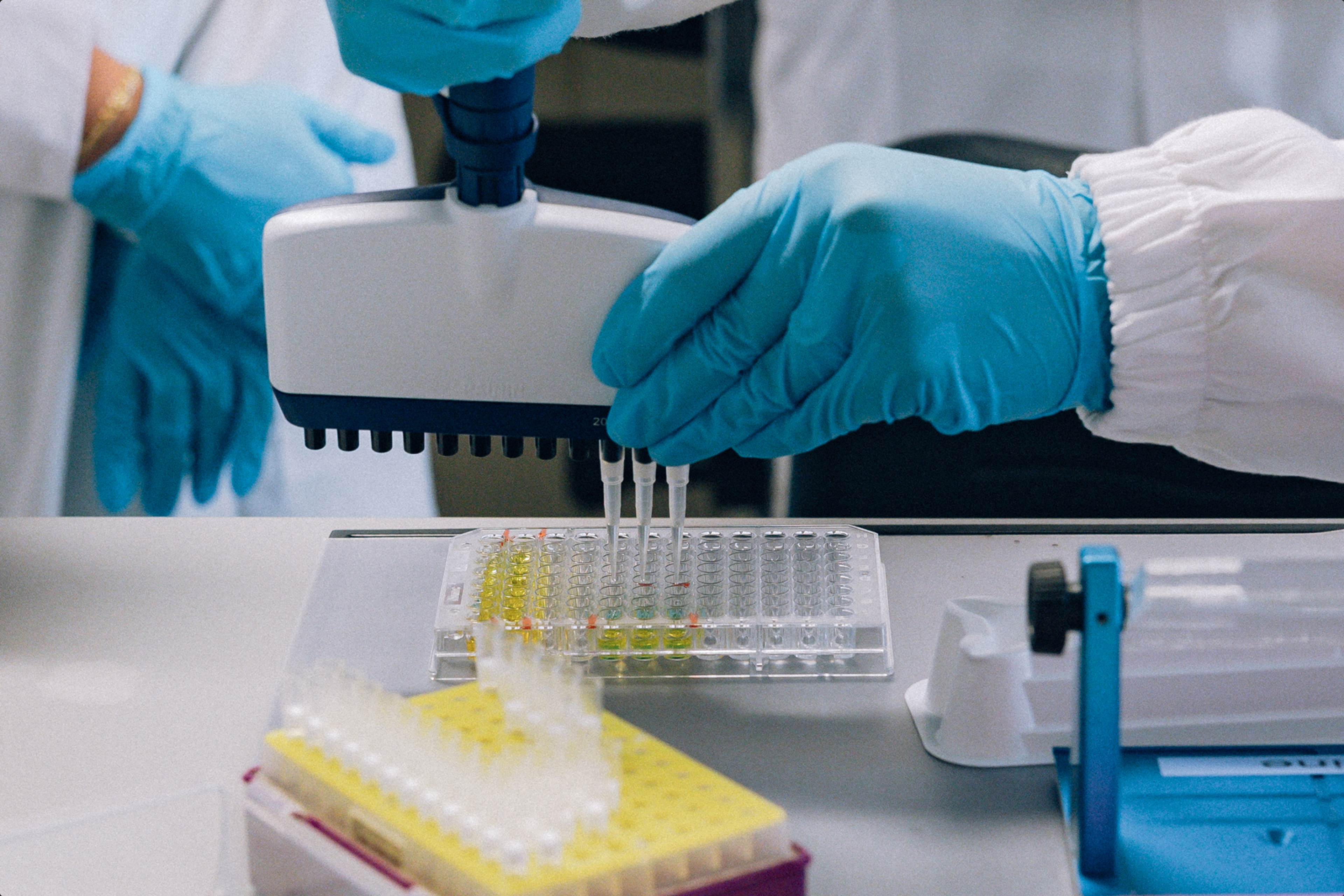
·
Nutrition·
Studies·
